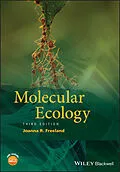A fully updated guide to the increasingly prevalent use of molecular data in ecological studies
Molecular ecology is concerned with how molecular biology and population genetics may help us to better understand aspects of ecology and evolution including local adaptation, dispersal across landscapes, phylogeography, behavioral ecology, and conservation biology. As the technology driving genetic science has advanced, so too has this fast-moving and innovative discipline, providing important insights into virtually all taxonomic groups. This third edition of Molecular Ecology takes account of the breakthroughs achieved in recent years to give readers a thorough and up-to-date account of the field as it is today.
New topics covered in this book include next-generation sequencing, metabarcoding, environmental DNA (eDNA) assays, and epigenetics. As one of molecular ecology's leading figures, author Joanna Freeland also provides those new to the area with a full grounding in its fundamental concepts and principles. This important text:
* Is presented in an accessible, user-friendly manner
* Offers a comprehensive introduction to molecular ecology
* Has been revised to reflect the field's most recent studies and research developments
* Includes new chapters covering topics such as landscape genetics, metabarcoding, and community genetics
Rich in insights that will benefit anyone interested in the ecology and evolution of natural populations, Molecular Ecology is an ideal guide for all students and professionals who wish to learn more about this exciting field.
Autorentext
JOANNA R. FREELAND is a Professor in the Department of Biology at Trent University, Peterborough, ON, Canada. She has been a researcher in the field of molecular ecology for more than 20 years, with particular interests in invasive species and conservation genetics.
Inhalt
About the Companion Website Page xiii
1 Molecular Genetics in Ecology 1
What is Molecular Ecology? 1
DNA, RNA, and Protein 2
Allozymes 5
DNA: An Unlimited Source of Data 7
Mutation and Recombination 8
Epigenetic Marks 10
Genomes 12
Mitochondrial DNA (mtDNA) 13
Chloroplast DNA (cpDNA) 13
Haploid Chromosomes 16
Polymerase Chain Reaction 16
Quantitative PCR 19
Sources of DNA 21
Getting Data from PCR 22
Fragment Sizes 22
DNA Sequencing 25
High Throughput Sequencing 26
Overview 28
Chapter Summary 29
References 29
2 Molecular Markers in Ecology 35
Understanding Molecular Markers 35
Neutral Versus Adaptive Markers 35
Genomes 36
Animal Mitochondrial DNA (mtDNA) 36
Plant Mitochondrial DNA (mtDNA) 39
Chloroplast DNA (cpDNA) 39
Haploid Chromosomes 42
Uniparental Markers: Some Final Considerations 43
Molecular Markers 44
Early Developments in Molecular Markers 45
Allozymes 46
PCRRFLPs 46
Random Amplified Polymorphic DNA (RAPDs) 47
Inter Simple Sequence Repeats (ISSRs) 48
Amplified Length Fragment Polymorphisms (AFLPs) 49
Modified AFLPs: MethylationSensitive Amplified Polymorphisms (MSAPs) 50
Microsatellites 51
DNA Sequencing 56
Sequencing a Single Region of DNA 56
Single Nucleotide Polymorphisms (SNPs) 59
High Throughput Sequencing (HTS) 61
RAD Sequencing 62
GenotypingbySequencing (GBS) 63
Targeted Sequence Capture 63
WholeGenome Sequencing 64
Overview 65
Chapter Summary 65
References 66
3 Species 71
Species Concepts 71
DNA Barcoding 73
Barcoding Applications 76
Barcoding Limitations 79
Metabarcoding 81
Metagenomics 84
Barcoding and Metabarcoding Environmental DNA (eDNA) 87
Overview 91
Chapter Summary 91
References 92
4 Phylogeography 101
What is Phylogeography? 101
The Evolution of Phylogeographic Data Sets 102
Molecular Clocks 104
Bifurcating Trees 109
The Coalescent 115
Networks 117
ModelBased Phylogeographic Inference 120
LongTerm Climatic Fluctuations 121
GlacialInterglacial Cycles 121
Marine Refugia 123
FarReaching Effects of Glaciation 125
Dispersal and Vicariance 125
Lineage Sorting 127
Hybridization 130
Applied Phylogeography: Biological Invasions 133
Overview 136
Chapter Summary 136
References 137
5 Genetic Analysis of Single Populations 149
Why Study Single Populations? 149
What is a Population? 149
Quantifying Genetic Diversity 151
HardyWeinberg Equilibrium 152
Estimates of Genetic Diversity 157
Haploid Diversity 160
Choice of Marker and Genome 162
What Influences Genetic Diversity? 163
Genetic Drift 163
What is Effective Population Size? 164
Census Population Size (Nc) 165
Effective Number of Breeders (Nb) 165
Estimating Ne from Demographic Data 165
Estimating Ne from Genetic Data 166
Estimating Ne: A Cautionary Note 170
Ne, Genetic Drift, and Genetic Diversity 173
Population Bottlenecks and Founder Effects 174
